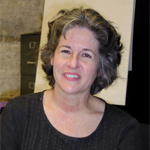|
|||
| << STATE OF THE ARTS HOME | |||||||||||||||
|
by Marianne Combs Minnesota Public Radio November 22, 2002 McKnight, Jerome, Target, General Mills: for many artists these foundations are vital to their ability to survive doing what they love. Minnesota has more than 135 foundations giving money to the arts, and their long history of generosity has made the state a leader nationwide in arts funding. But recent reports suggest that reputation is no longer as justified. The economic recession has left its mark and 2003 promises to be a tough year for artists and foundations alike. St. Paul, Minn. — Linda Andrews has been running Zenon Dance company for 20 years. She remembers when times were so tough the company ran a pull tab operation in a nearby bar to make ends meet. Things are better now. Andrews runs an office with two full time staff and one part timer, plus numerous dancers who volunteer their time in exchange for free classes. The company runs a dance school which helps pay for the expenses associated with putting on concerts. But still Andrews says over half of her budget comes from philanthropic support. And in the past couple of years she's seen some of the smaller foundations cut their support for the arts. "Things are different," says Andrews. "Attitudes are different, life is different since September 11th and we're rethinking all of that in trying to really be as intelligent and creative as we can." Every two years the Minnesota Council on Foundations surveys arts funding. It also determines where the arts stand as a funding priority, based on its percentage of charitable giving. The numbers for 2001 are not yet available, but from 1997 to 1999 there was a steep decline. Giving to the arts in Minnesota dropped by 10%, and while in 1997 the arts received 17% of charitable dollars, in '99 it received only 13%. As it stands, Minnesota giving is now just "average" compared to the rest of the nation. President of the Jerome Foundation Cyndi Gehrig says she's concerned by the numbers.
"13 % isn't acceptable," says Gehrig. "We have to get that up and I think we need an awareness of the fact that we have an incredibly strong cultural community in this state that deserves a higher percentage of our grantsmaking dollars and I think we need to go higher." Gehrig says the last time Minnesota's arts giving dropped this low it sparked a statewide initiative to raise support. But the latest election results only compound her worries: "I remain ever hopeful but historically Republican administrations have not been recommended substantial increases in public funding for the arts," says Gehrig. "I hope I'm proven wrong with this administration but if we look back in history that's been the case." Gehrig says in past years when government funding has dipped, the Jerome Foundation has come forward to try to help fill the gap. But her office has been hard hit by the economy. This year the foundation is cutting it's funding to the arts by $200,000. In addition it's taking a heavy administrative cut. Gehrig says even if the economy bounces back in the next few months, the Jerome Foundation will need much longer to recover. McKnight Foundation's Neil Cuthbert says every source of revenue for arts organizations has been effected in the past year. Patrons are cutting back on buying tickets, the state is cutting it's funding, and private foundations are cutting back on their grants. "I think what's going to make this next year in particular really challenging is that it's hit on so many fronts," says Cuthbert. "In the past it's hit on one front or maybe two, but this one is hitting on a lot of different levels - and that's going to be challenging." Cuthbert says his own foundation's numbers dropped in 1999, not because McKnight was cutting back on its giving, but because artists simply weren't asking for it. Several capital campaigns had just ended and others had yet to take their place. As a result, the McKnight foundation gave $2 million dollars less that year. But with a whole slew of new capital campaigns in the works - from the Guthrie theater to the Minnesota Orchestra - Cuthbert expects Minnesota foundations will be giving a lot of their money to the arts this coming year. The only problem: he doesn't think there will be enough to meet their needs. "We've lost hundreds of millions of dollars. When you lose hundreds of millions of dollars, you give out less money. We're giving out less money," says Cuthbert. The Minnesota Council on Foundations report on giving to the arts was spurred, in part, by the realization that so many capital campaigns were launching just the economy was slowing and hindering the ability of foundations to give. The council talked to funders and artists about the strengths and weaknesses of arts funding and found several key areas needing improvement. One of them is funding for arts organizations outside the Twin Cities. Robert De Armond sits in a small office in Duluth. As head of the Arrowhead Regional Arts Council, DeArmond is responsible for providing grants to arts organizations in northeastern Minnesota - almost a quarter of the state. His money comes from the McKnight Foundation and the Minnesota State Arts Board. But this past year the State Arts Board took a 4% budget cut. Next year the Board has been asked to trim an additional 10%. DeArmond says any cut is a major blow to his organization and to the arts groups which rely on his financial support. Unlike the Twin Cities where arts organizations have several funding options, out here he's pretty much the only game in town. "I think the difference is they have access to funding that my groups don't," says DeArmond. "I'm it for them. If I get hurt badly and don't have the money for them, they don't have other foundations they can go talk to." DeArmond says many Minnesota foundations don't have a mission to fund outside the metro area - other foundations simply dont have the staff or means to administer funds to outstate Minnesota. However his Regional Arts Council is a ready structure in place, and he says he's more than willing to channel funds from other foundations. He says he's solicited donations without much success. He muses many foundations might have a problem letting someone else manage their money. The St. Paul Foundation's John Couchman says artists and funders need to change how they look at arts funding. Couchman says the tendency to obsess over numbers and percentages leads to what is sometimes an unhealthy competition amongst organizations who should be working together.
"The pie is the pie. It will continue to grow at times, it might diminish at times and what makes this community and all communities is when we look at the inner relationship of what makes life strong, healthy, rewarding, worthwhile for everybody, and when we start dividing pies we lose the ability to do that," says Couchman. Traditional grants go to support specific activities of an arts organization, or just the basic costs of doing business. Couchman says the downside of such grants is that once they disappear, often the artists who depend on them disappear as well. Couchman is an advocate for a new type of funding called "building capacity grants." Such grants are aimed at increasing an arts organization's efficiency while decreasing its dependence on outside funding. These grants are gaining popularity with some foundations in light of tougher financial times. The St. Paul foundation is just finishing up its first run of a new ArtsLab, a three year project working with eight arts organizations to develop more effective means of working with the public and one another. Back at Zenon Dance company, Linda Andrews says she welcomes the opportunity to build the capacity of her own organization, but frankly she can't imagine a day when Zenon didn't rely on foundation and corporate support: "We need the operating support," says Andrews. "We have so much preparation time; we spend two to three months preparing and rehearsing, bringing choreographers in, all of those expenses, dancers salaries. By the time we perform, with the cost of the venues we never make any money." Andrews says she already feels she's scraping to find the funds she needs now. She can't imagine what it will be like if she takes additional cuts from funders in the coming year. Meanwhile Duluth Superior Symphony Orchestra Executive Director Andrew Berryhill is optimistic. Orchestras are well supported by individual donors compared to other arts organizations, so the DSSO only relies on foundations for 10% of its budget. Berryhill says the coming year's financial challenges may actually be an energizing force, driving his symphony to be stronger, smarter, more creative and more versatile. "We are not in the entertainment business," says Berryhill. "We are not in the just existing business. We are charged with being vital with being interesting. We may not be able to be as 'big' - if you're defining 'big' as how big you're operating budget is - but we can certainly be interesting, and that's up to us." One of the surprising revelations of the Minnesota Council on Foundation's report on arts funding was the misperception of a decline in corporate giving. Many artists express concern at the disappearance of major funders like Honeywell, who moved, taking their funding with them. But corporate support for the arts has steadily grown over the past years. Minnesota Council on Foundations president Bill King says the numbers just dont support the rumors.
"We've had about 15-16 Fortune 500 companies in this community throughout the loss of places like Honeywell and we continue to have those companies here and they are engaged in philanthropy - so there's been some replacement as we've gone along. It would be great if the mergers and acquisitions environment wasn't out there and everybody stayed home and supported their hometown communities, but the world changes and our community has changed and we haven't necessarily been weakened by that." King says it's important to remember foundations are not the largest supporters of the arts. He says everyone has a role to play in arts funding across the state. "One of the lessons that we learned in all of this work is that foundation and corporate philanthropy is just one piece of the pie of all philanthropy. Individuals really comprise the largest piece of that pie - about 80% of all philanthropy comes from individuals with the remainder coming from foundations and corporations." King says Minnesota's national reputation as a leading funder of the arts will not be assured or ruined by whatever happens in the next year - and he's confident the economy will bounce back shortly. But how the state government, foundations and artists deal with the coming year's financial challenges will determine the health of the arts community in Minnesota for years to come. |
|||||||||||||||


